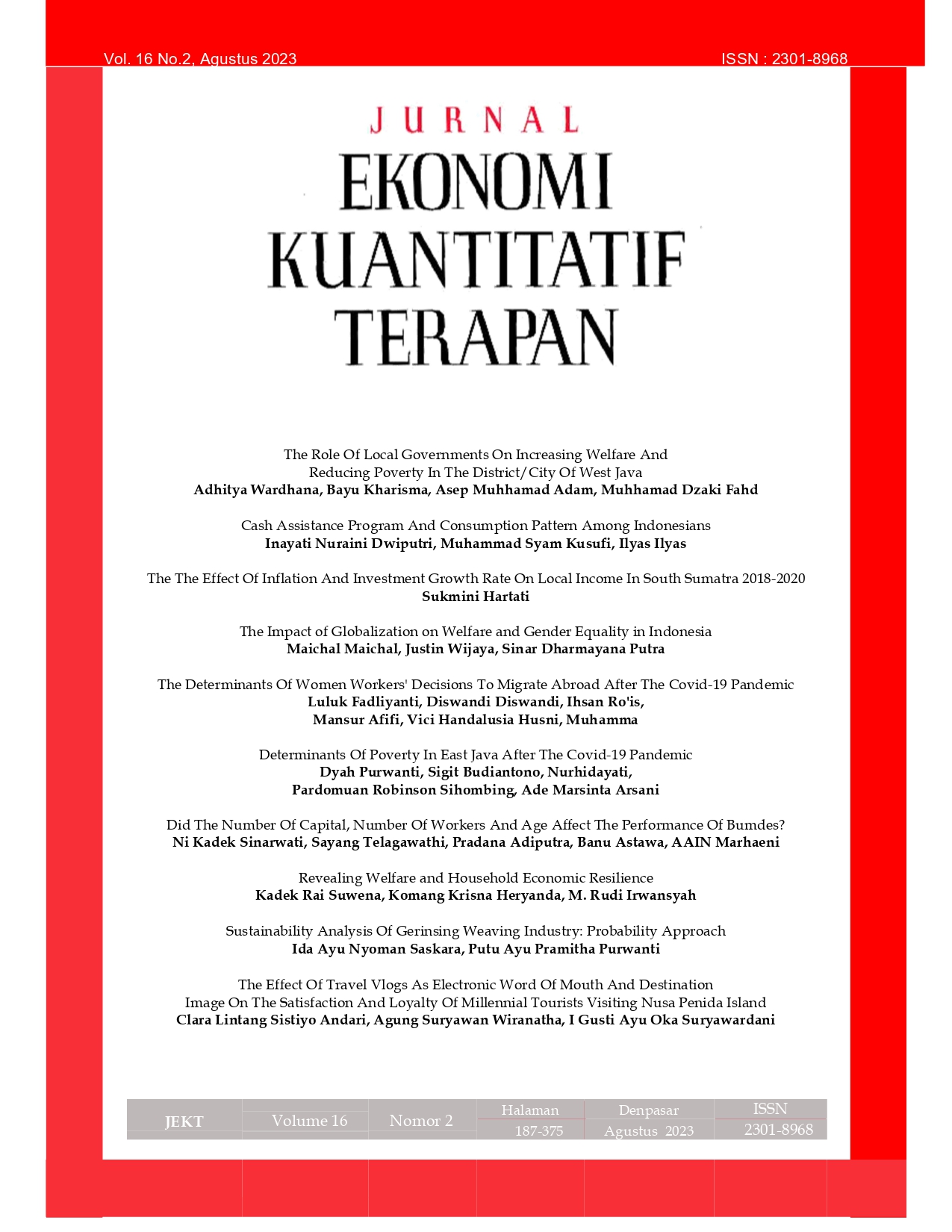The Effect of Travel Vlogs as Electronic Word of Mouth and Destination Image on the Satisfaction and Loyalty of Millennial Tourists Visiting Nusa Penida Island
Abstract
Satisfaction and loyalty become a measure of the success of a tourist destination. Electronic word of mouth and destination image are two factors that can affect the satisfaction and loyalty of millennial tourists who visit a tourist destination. The purposes of this study were 1) To analyze the effect of travel vlogs as electronic word of mouth on satisfaction and loyalty of millennial tourists visiting Nusa Penida Island, 2) To analyze the effect of destination image on satisfaction and loyalty of millennial tourists visiting Nusa Penida Island, 3) to analyze the effect of satisfaction on the loyalty of millennial tourists who visit Nusa Penida Island. This research was used quantitative method involving 100 respondents who are millennial tourists visiting Nusa Penida Island. Sampling was done by purposive sampling method and analysis using Structural Equation Model (SEM) with SmartPLS 3.0 software. The results showed that 1) travel vlog as electronic word of mouth had significant effect on satisfaction and destination image had significant effect on satisfaction 2) travel vlog as an electronic word of mouth had significant effect on loyalty and destination image had not significant effect on loyalty, 3) Satisfaction had significant effect on loyalty. Other results showed that 81% of millennial tourists use social media as a source of information about Nusa Penida Island.
Downloads
References
Charo, N. et al. (2015) ‘Determining the Impact of Ewom on Brand Image and Purchase Intention through Adoption of Online Opinions’, International Journal of Humanities and Management Sciences, 3(1), pp. 41–46.
Chi, C.G.-Q. and Qu, H. (2008) ‘Examining the structural relationships of destination image, tourist satisfaction and destination loyalty: An integrated approach’, Tourism management, 29(4), pp. 624–636.
Chiu, W., Zeng, S. and Cheng, P.S.-T. (2016) ‘The influence of destination image and tourist satisfaction on tourist loyalty: a case study of Chinese tourists in Korea’, International Journal of Culture, Tourism and Hospitality Research [Preprint].
Ghozali, I. (2014) Structural Eeuation Model Metode Alternatif dengan Patrial Least Square Aplikasi. Cetakan ke empat. Semarang: Universitas Diponegoro.
Katadata (2019) Youtube Medsos No 1 di Indonesia, https://katadata.co.id/infografik/2019/03/06/Youtube-medsos-no-1-di-indonesia.
Kotler, P. and Keller, K.L. (2012) Marketing Management. Amerika Serikat: Prentice Hall.
Kurniawan, M.A. and Maftukhah, I. (2020) ‘The Analysis of Electronic Word of Mouth, Destination Image, and Visiting Decision on Satisfaction’, Management Analysis Journal, 9(1), pp. 72–80.
Machin, D. (2014) Visual Communication. De Gruyter Mouton Handbook of Communication Science Volume 4.
Pitana, I.G. and Diarta, I.K.S. (2009) Pengantar Ilmu Pariwisata. Yogyakarta: Penerbit Andi.
Pitana, I.G. and Pitanatri, P.D.S. (2016) ‘Digital marketing in tourism: the more global, the more personal’, in International Tourism Conference: Promoting Cultural and Heritage Tourism. Bali: Udayana University, pp. 1–3.
Putra, S.P.A.M. (2017) ‘Pengaruh Electronic Word of Mouth Terhadap Citra Destinasi, Kepuasan, dan Loyalitas’, Modus, 29(2), pp. 210–218.
Rizal, M., Rachma, N. and Priyono, A.A. (2019) ‘Analisis Pengaruh Electronic Word of Mouth Terhadap Loyalitas Destinasi Dimediasi Citra Destinasi Dan Kepuasan Wisatawan (Studi Kasus Pada Wisata Paralayang Kota Batu)’, Jurnal Ilmiah Riset Manajemen, 8(16).
Sudiarta, I.N. (2012) ‘Membangun Citra Destinasi Pariwisata Seberapa Pentingkah’, Jurnal Ekonomi dan Pariwisata, 7(31), pp. 1–13.
Tjiptono, F. (2004) Strategi Pemasaran. Edisi Kedua. Yogyakarta: Penerbit ANDI Yogyakarta.
Wiranatha, A.S., Suryawardani, I.G.A.O. and Bendesa, I.K.G. (2016) ‘Model of Foreign Tourist Loyalty on Marine Tourism to Visit Bali’, Journal of Global Stochastics Analysis, 5(8).
Zhang, H. et al. (2014) ‘Destination image and tourist loyalty: A meta-analysis’, Tourism management, 40, pp. 213–223.




















